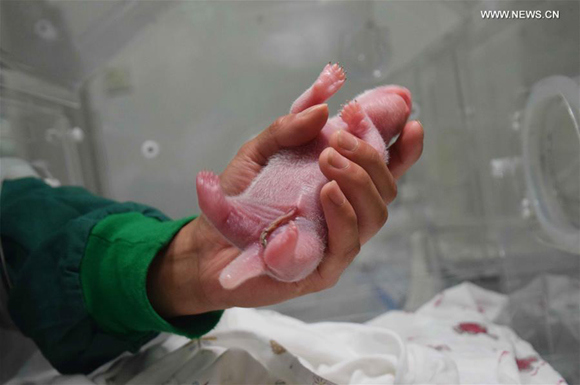
Photo taken on July 31, 2017 shows the world's first giant panda cub with both captive and wild parents in southwest China's Sichuan Province. (Photo/Xinhua)
The first giant panda cub born to a captive mother and wild father is in good health, according to China Conservation and Research Center for the Giant Panda (CCRCGP).
The male cub was born early Monday at the Hetaoping semi-wild training base in southwest China's Sichuan Province, the first success in encouraging captive pandas to mate with their wild counterparts in hope of increasing the genetic diversity of the captive stock.
The cub is being nursed by his mother, 15-year-old Cao Cao. Its weight has dropped to 185 grams from 216 grams at birth, a normal phenomenon for newborn giant pandas, according to his keeper He Shengshan.
The cub is much heavier than most captive newborns which weigh around 150 grams. Training base staff attribute his weight to the good health and appetite of Cao Cao during pregnancy.
The cub's weight will start to increase on his fourth day and by the seventh, he will appear more like a panda instead of a pink little mouse, with new black and white fur.
Cao Cao was born in the wild and rescued by the CCRCGP in 2003 at 2 years old. She has had six cubs, including two pairs of twins.
For most of the last seven years, she has lived at Hetaoping, where she has adapted well to life in the semi-wild.
Wearing a tracking device and a recorder on her neck, Cao Cao was released into the wild on March 1 and stayed at large for nearly two months.
The recording device showed that she went into heat on March 11 and searched for a wild mate by herself. She mated with a wild male panda on March 23.
The CCRCGP began to experiment last year with ways of bringing in genes from the wild population to improve the quality of the gene pool.
As of the end of last year, the worldwide captive giant panda population stood at 471, leading to growing concerns of inbreeding.


















































